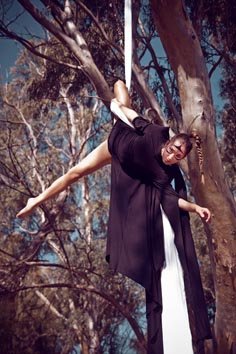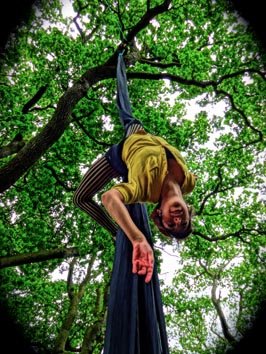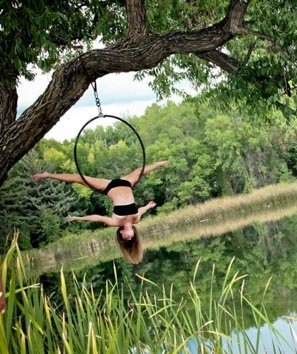Being close to regular aerial circus classes is a luxury for many people. It can be tempting to rig your aerial silk, aerial hoop, trapeze or corde lisse from that sturdy looking tree in your back garden or in your local park. A free training space in beautiful surroundings – sounds idyllic but it is unlikely to be safe.
The short answer to “can I rig my aerial circus equipment from a tree?” is “no”. Firetoys strongly recommends you do not rig from trees on safety grounds. It is a much better and safer option to invest in an outdoor (or even indoor) aerial rig to practise from in the convenience of your back garden or local park.
However, we know some of you are going to rig in trees anyway so we’ve done some research and written this article to highlight the most important considerations you need to take into account if you want to know how to rig a silk, aerial hoop, trapeze, rope or other piece of aerial circus kit from a tree. This is not a guide to rigging in trees or an exhaustive list of the safety precautions. Please research further before attempting to rig in a tree.
The risks involve not only injuring or killing yourself but your spotter and passers-by as well if the branch breaks. If everyone is lucky enough to walk away from such an accident then there is the damage to the tree and to the reputation of aerial circus to consider. While an element of risk is inherent in aerial circus, these risks can be minimised and they are by all reputable practitioners. Accidents caused by irresponsible rigging risk aerial circus being seen as seen as a very dangerous activity that may put people off trying it, stunting the growth of this art. It could also adversely affect people being able to get insurance, jeopardising the ability for them to teach and perform.
Before rigging anything in a tree you should consult both a professional arborist and a professional rigger. To put it bluntly, unless you have training in these things you will not know the strength of the branch you intend to rig from. This is hugely dependent on the species of tree and its health. The tree may look big and strong enough but disease or poor health of the tree can mean it’s actually very fragile.
Understanding the forces you’re likely to exert on the tree is another essential factor. Your weight, and the weight of the equipment, will account for the static load being applied to the tree. However, you will also need to consider how dynamic your movements will be on the equipment – how much do you move? Will you be practising drops? In testing it has been found that the forces generated by dynamic circus routines can reach peak momentary loads (the maximum force exerted on the anchor during the routine) of between double the static load for less dynamic apparatus like aerial hoops and five times the static load for more dynamic equipment like flying trapeze or during drops on silks. Dynamic moves on free ropes will fall somewhere in between as the rope absorbs some of the force.


The tree branch itself is also putting pressure on the join it makes with the trunk so the weight of the branch also needs to be taken into account. The position of your rig along the branch is also important as it will be acting like a lever so the further you are from the trunk the higher the moment you will be applying to the branch. You should rig as close to the trunk as possible.
You also need to consider the health of the tree. Damaging the tree or branch can reduce the tree’s strength over time. The branch might be strong enough today but if you damage it, it may not be strong enough next week, next month or next year risking future injuries to yourself or others. Precautions should be put in place to avoid this. Chances are that these precautions will also help to protect your equipment from being damaged by the tree. This is another important safety consideration – the rough bark of a tree may reduce the integrity of your rigging equipment.
Redirects or guying, where the branch of the tree is supported by and secured to other large branches or the tree’s trunk, is another vital safety measure. This reduces the risk of a breakage but also reduces the risk of the branch landing on you if it does break. This is another thing that can only be done correctly by a trained arborist. You may not be able to see at this size but there are redirects in Celestina's photo on the left.
After taking all these considerations into account you should also apply a test weight to the branch that is well above the load you expect to exert on the branch, remembering that dynamic moves greatly increase the force.
After taking all these considerations into account you should also apply a test weight to the branch that is well above the load you expect to exert on the branch, remembering that dynamic moves greatly increase the force.
You should also only be considering this if you are an experienced aerialist – learning new moves, particularly with silks, rope or straps, on your own is a very bad idea. And no, YouTube and books are NOT a substitute for a professional instructor. Even if you are confident in your abilities you should never train alone. Just like your normal, indoor training, your spotter should also be experienced and know how to get you out of a move gone wrong and spot that a drop or wrap is wrong before it’s attempted. You should also be wearing suitable clothes and have a crash mat or something similar to help break your fall should you be unfortunate enough to have one.
To reiterate, we recommend never rigging from a tree unless you have the thumbs up from people with the relevant expertise. You should also research as much as you can; we make no pretence that this article contains everything you need to know.
As already mentioned, there is always risk involved with aerial (or anything else) and it’s down to personal responsibility to ensure your own safety and that of others. Risking your own life is one thing but endangering other people is another. However, with the proper precautions and the right information, rigging from a tree can be as safe as rigging indoors. It’s just much more difficult to do safely than it is indoors. Given the difficulty and potential expense involved with this we still reckon you’re better off with a rig like one of these!

Photo Credits:
(Please do NOT attempt to recreate the setups in any of the pictures in this article.)
Siobhan Johnstone by David Greensmith Photography www.siobhanjohnstone.com
Evgenia Galeraki by Periklis Ripis www.evgeniagaleraki.com
Celestina Mancha by Simon Walker
Natalie Keller




